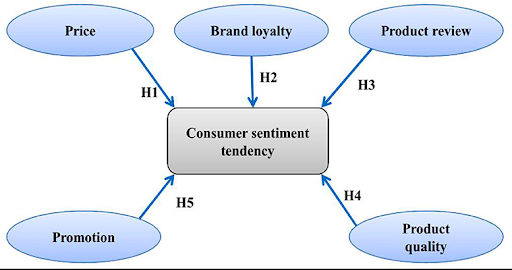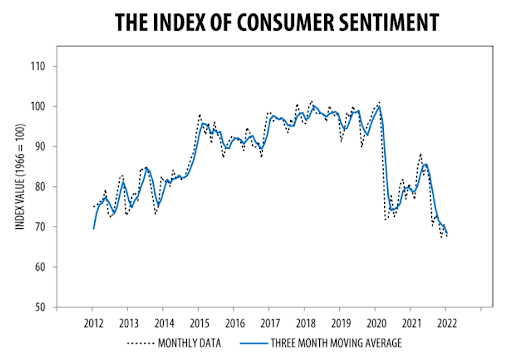Consumer Sentiment
Definition
Consumer sentiment refers to consumer opinion on their financial health. It indicates how willing the consumers are to spend money.

Description

In a survey report by University of Michigan, it was shown that the consumer sentiment fell throughout the month of January 2022.
Consumers form an essential part of the market, and their attitude, feelings, and behaviour within a market determine how the market will roll. The sentiments define how optimistic the consumers feel in a state of economy.
Consumer sentiments are based on their financial situation and how they feel about spending money. Therefore, the study about the behaviour of consumers helps brands predict the market’s future.
Consumer sentiments are the key indicators of the overall health of the economy. When consumers feel confident about the nation’s overall economy, they are more interested in spending.
Example
After Covid-19, many nuclear families saw the economy slow down during the shutdown era. India’s $2.9 trillion economy remained shuttered during the lockdown period.
Though many companies worked on a half-pay scale basis, a large part of the population had to leave jobs. As a result, the spending power reduced considerably during that time which disrupted the economy and affected the consumer’s sentiments.
Also Read – Why You Need a Professional SEO Consultant?
How Consumer Sentiments Help the Brands or marketers?
Consumer sentiments help the marketers or the brands to understand in which context should the marketing efforts flow to help engage the consumers that allow the brand to grow.
Observing consumer sentiments is essential for investors because it indicates how much demand there will be for the goods and services produced by the companies.
Marketers know how and when they should divert their marketing efforts to convert the audience into loyal customers. The consumer sentiment data makes the brands aware of what kind of advertising will appeal to the consumers.
When consumers’ sentiments are observed closely, the companies can direct their efforts to reduce the gap between the client’s expectations and the delivery.
How to evaluate consumer sentiments?
Consumer sentiment for brands is the best way to gauge how the consumers will react to a product, event, or a campaign.
Sentiments define how consumers will engage with a particular product. This is how you can measure consumer sentiments:
1. Ready for word-of-mouth recommendations:
See how willing your consumers are to recommend your product to anyone. You can find their true opinion about your product using a questionnaire. You can ask questions from the consumers that will help you evaluate whether your consumers are passives, promoters, and detractors.
2. App ratings:
If you run an app and see that your consumers have given feedback on your app, it is a great sign. For a positive rating you can understand what the consumers were looking for. And for negative feedback, you can find out the areas of improvement in the product.
3. Direct feedback:
Use customer feedback form or chats to find out in direct how the consumers feel about the product you sold them. The feedback from the consumers can be translated into data for use.
4. Social media shares:
If your consumers like your product or service, it is most likely that they share about it on social media. Any feedback given there can also be taken as a metric to evaluate the consumer’s sentiments. Shares and mentions help you to use the inputs for further publicity.
Consumer Sentiments-Why is there a need?
There are a few reasons why evaluating consumer sentiments are important:
- Deep insights: It gives deep insights into what the audience is thinking about the brand and what it is that they look for in future.
- Real-time status: Consumer sentiments may change according to the changing lifestyles and external factors like a pandemic or political crisis. Hence it is important for the brands to market their products accordingly.
- Helps improve customer service: When you evaluate consumer sentiments, it helps you improve the customer service also. Like a delay in delivery can spoil the experience for a long time and the consumer may not order anything from you anytime soon.
- Prevents poor publicity of the brand: It prevents your brand from getting tarnished with the poor publicity. You can quickly take corrective actions to fix the damage and make your customers happy.
FAQs
How does consumer sentiment affect the market?
Consumer sentiments are primarily positive when there is an increase in consumer spending power. When the consumers have stable spending power, the economy looks for expansion. On the contrary, if, for a reason, the consumers feel less confident about spending money, it affects the business expansion. The sales decrease, and the market slows down.
Why is it important to gauge consumer sentiments?
The consumer sentiment index adds clarity and provides insights into the information:
- About their own financial situation
- Long-term general economy
- Short-term general economy
What does consumer sentiment tell you?
Consumer sentiments can tell a lot about the economy of a country. It means you about:
- Consumer confidence: Consumer sentiment is mainly dependent on consumer confidence. The two are strongly correlated because only when the consumer is confident it spends further, leading to market expansion.
- Consumer spending: It tells how willing consumers are to spend on a product that depends on their money in the bank.
- Consumer attitudes: Consumer sentiments will also define consumer attitudes, indicating where consumers are willing to spend.
Who uses consumer sentiment evaluation?
Evaluating consumer’s sentiments are primarily important :
- Manufacturers: Manufacturing units need to keep an eye on consumer sentiments because it affects their investment and production.
- Retailers: Retailers analyse consumer sentiment to increase revenues and guide plans and initiatives. As was the case at the beginning of 2020, consumer sentiments shift swiftly, so do the things people want to buy.
- Finance: Consumer sentiments rule the flow of cash into and out of the financial institution. The sentiments can affect the rate of interest and loan volumes. When the demand for a loan is high, the interest rates on the bank are also high and vice versa.
How do you analyse consumer sentiments?
You can analyse consumer sentiments by:
- Gathering feedback from the customers.
- Deploying live chat bots to collect customer data.
- Watch social media to know about consumer’s sentiments.
- Find the product reviews and feedback across different platforms.
- Online surveys can help evaluate consumer’s sentiments.





We would love to have your opinion.